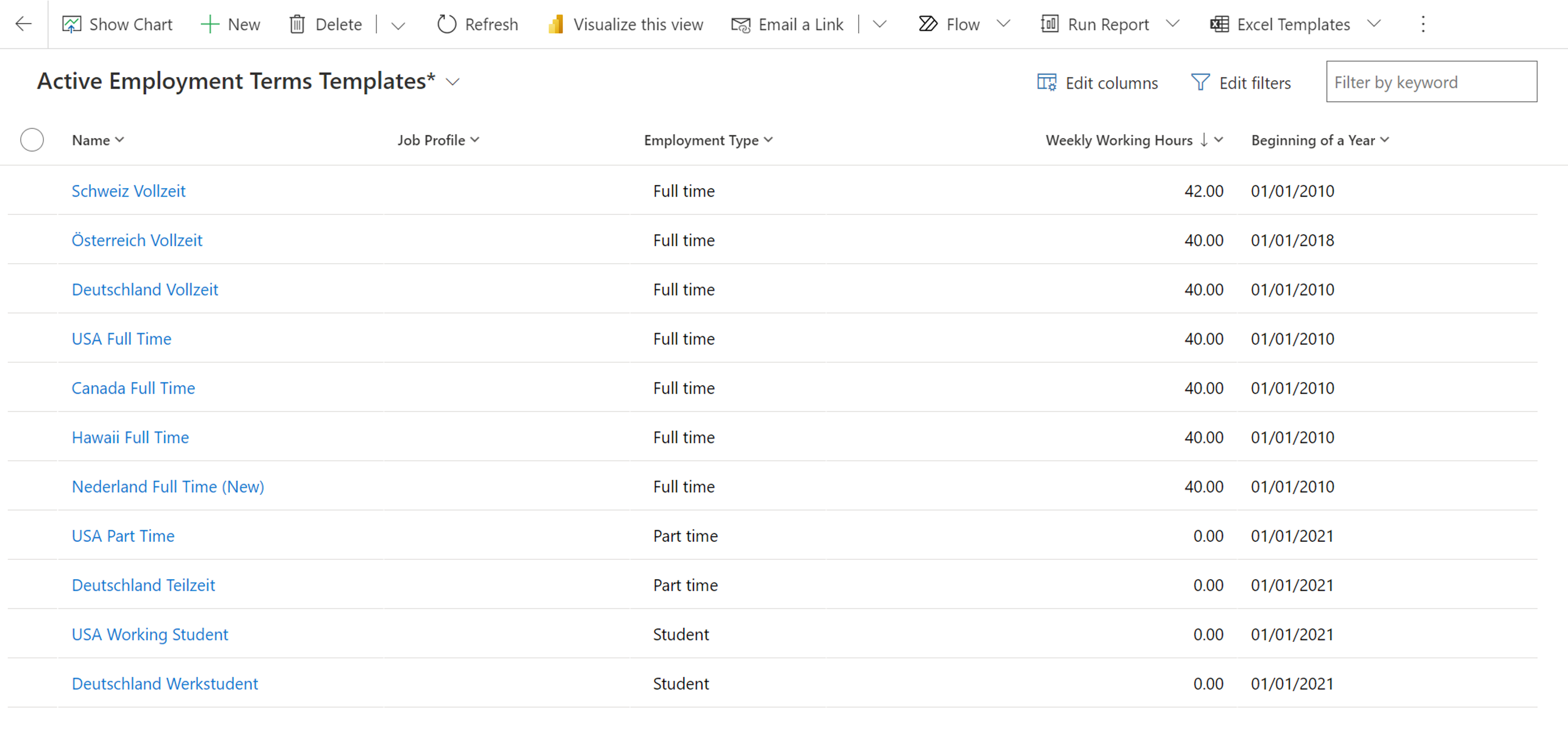This page takes you through the process of configuring Employment Term Templates in your system.
Employment Term Templates are based on the most common Employment Terms conditions in your organization.
These Templates are used to transfer recurring information (e.g. weekly work time, days of leave entitlement) directly into every new Employment Term, which will save you a lot of time in your day-to-day work.
Create Employment Term Templates
Objective
Process
HR Manager
Create Employment Term Template
HR Manager
Add details
HR Manager
Optional: Configure Work patterns
HR Manager
Optional: Configure Time Accounts
Click Through
- Log into your HR system with an HR Manager account and select the App HR HUB
- In the lower left corner, switch from Overview to Settings
- Go to Employment Terms Templates and press + New
- Fill out the required fields:
- Name: We recommend the name displays the most important data (work hours, leave entitlement) at first glance
- Job Profile: This allows you to associate the template with a job description. Optional to fill
- Beginning of a Year: Enter the beginning of your fiscal year (usually January 1st). Leave entitlements are calculated based on this date
- Employment Type: Select type of employment. By default you can choose between Full Time, Part Time, Student, Seasonal, Trainee/Voluntary, Internship, Temporary Work and Contract Worker
- Terms of Notice: Enter the period of notice
- Terms of Notice Probation: Enter the period of notice during probation
- Probation Period (Month): Enter the duration of probation in month
- Payroll Period: Select the period in which payments are made. By default you can select weekly, Bi-weekly/fortnightly, Semimonthly, Monthly, Yearly and One-time. Be aware that you have to choose the same payroll period for affiliated wages
- Save the record. After the record has been saved for the first time, additional sections show up
- Click the Ellipsis (3 dots) in the sector Countries/Region, then on Add existing area
- Define for which country or region this template is available
- Click the Ellipsis (3 dots) in the sector Leave Entitlements, then on + New Leave Entitlement
- Fill out the required fields for the leave entitlement:
- Absence Type: Define the absence type for the leave entitlement
- Entitlement: Define how many days or hours the entitlement should have. Depending on time unit (hours vs days)
- Process Remaining: Define if remaining days at the end of the period automatically get transferred to the new period, automatically get booked out or if they are transferred manually
- Entitlement Type: Define the entitlement type for the leave entitlement
- Save the record
- If you have specific groups of employees in your organization who have irregular work hours, you can create Employment Terms Templates dedicated to those groups. In their Templates, activate work patterns in the Working Hours section
- You can find a detailed setup of work patterns in our Time & Attendance module. All you need to do right now, if you want to use it later, is activate the option inside the Employment Term Templates.
- Navigate to the section Working Hours
- Enter how the total working time of your Employment Terms Template is distributed over the individual days of the week
- Doublecheck all entries, then Save & Close
- Your Employment Terms Template is now ready for use
- Repeat these steps to set up Employment Terms Templates for all common work contract scenarios in your organization
- Optionally, you can create work patterns or time accounts for your employees
Hint
- Leave entitlements added to the Employment Terms Template will be added as default to new employment terms that are based on this template
- The weekly working hours get calculated based on the individual daily working hours as defined in the Working Hours section (or the Work Pattern, depending on what was used).
Recommendations
- We recommend taking some time here to set up detailed Employment Term Templates for all your common use cases. It will save you a lot of time in your day-to-day work with HR for Dynamics later.
Result
- Employment Terms Templates are the basis for all Employment Terms you create in the system.
- Employment Terms will be created later in your Base Setup process.
Here you can see the view of a list of Active Employment Terms Templates:
Next step (Self-implementation Path)
- After creating Templates for all types of Employment Terms your company uses regularly, it's time to import your employees into HR for Dynamics. This process will create Digital Personnel Files for all your employees.
